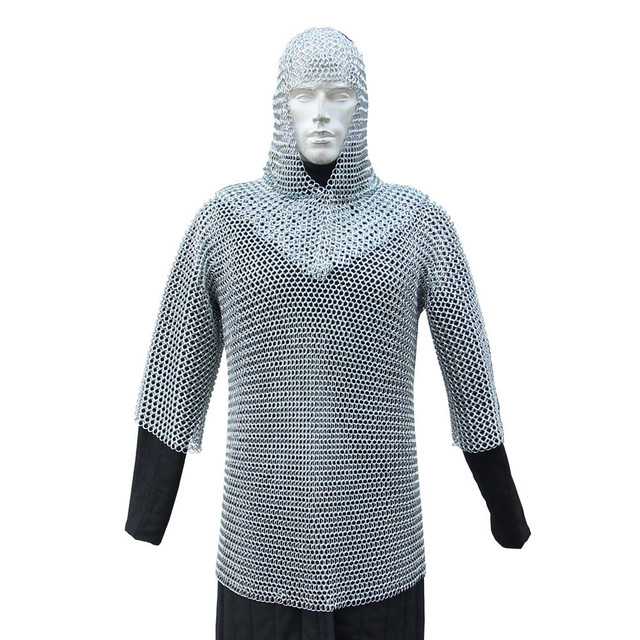Separating Fact from Fiction in the History of Body Armor
Posted by Swordsswords on Feb 6th 2024
Contrary to popular belief, body armor wasn’t standard issue for Roman soldiers. The truth is far more fascinating - the first widespread use of chainmail actually belongs to the Celts centuries earlier. Crafted from painstakingly linked iron rings, this early armor offered remarkable protection for its time, revolutionizing warfare on the battlefields of ancient Europe.
But chainmail is just one chapter in the rich and often misunderstood history of body armor. From the humble beginnings of leather cuirasses to the high-tech ceramics of modern bulletproof vest, this blog aims to separate fact from fiction, debunking myths and exploring the surprising evolution of this life-saving technology. So, join us on a journey through history, as we peel back the layers of misconceptions and dive deep into the fascinating world of armor across different eras and materials!
Busting Body Armor Myths: From Hollywood Hype to Historical Heroes
The history of body armor is full of fascinating truths. Spartan warriors, for example rarely sported the full-blown plate carrier we see today. Instead, they relied on soft armor plates and greaves, prioritizing mobility over head-to-toe protection.
Then there's the samurai, often depicted as invincible in their elaborate metal suits. While their functional body armor was indeed impressive, it wasn't impenetrable. Strategic strikes to that soft armor and advancements in weaponry throughout history meant even the best samurai armor had its limitations.
And let's not forget the romanticized image of chainmail deflecting arrows with ease. While it offered superior protection compared to leather, chainmail wasn't an arrow-repelling force field. The tightly woven rings could still be pierced, especially by heavy arrows shot from powerful bows.
Digging Beneath the Armor Plate: Facts of Body Armor History
Each material of medieval armor, from the sturdy iron of medieval plate to the cutting-edge ceramics of modern vests, tells a story of effectiveness against ever-changing threats.
Material Marvels:
- Bronze: This soft armor offered good protection against slashing weapons and was lighter and more malleable, allowing for intricate designs. Did you know the iconic Etruscan warriors were known for their bronze greaves and helmets?
- Iron: As technology advanced, iron became the go-to metal, offering superior strength and affordability. From the iconic chainmail of the Celts to the plate armor of medieval knights, iron revolutionized protection on the battlefield.
- Steel: Taking things a step further, steel offered even greater strength and lighter weight, eventually leading to the hard armor plates we associate with knights. Interestingly, the Japanese developed a unique hardening technique for steel, creating their distinctive samurai armor.
- Ceramics: The modern era ushered in new materials like ceramics, offering incredible ballistic protection in lightweight armor plates. These are often used in conjunction with other materials to create composite vests with enhanced protection and flexibility.
Beyond the Metal:
- Leather: Not to be underestimated, leather played a crucial role throughout history. From the simple tunics of early warriors to the sophisticated lamellar armor of the Mongols, leather offered surprisingly good protection against slashing weapons and arrows, while being readily available and relatively lightweight.
- Bamboo: This readily available material offered surprising protection in Southeast Asia. Woven into intricate armor, bamboo could deflect arrows and even absorb the impact of some blades, making it a valuable resource for local warriors.
Evolution and Trade-offs:
Each advancement in body armor design was driven by changing warfare tactics and technologies. For example, the rise of gunpowder led to the development of armor plate to deflect bullets, while the need for increased mobility on the battlefield spurred the creation of lighter and more flexible alternatives.
However, there were always trade-offs. Heavier armor, like full plate, offered superior protection but restricted movement. Lighter options, like padded armor, sacrificed protection for agility. Understanding these trade-offs is crucial in appreciating the ingenuity and strategic considerations behind each armor type.
Fascinating Tidbits:
- Did you know the Romans sometimes used linen armor, surprisingly effective against arrows due to its layered construction?
- The Japanese samurai perfected the art of lacquering their armor, not just for aesthetics but also to enhance its weather resistance and durability.
- Mongol warriors often used captured enemy armor, highlighting the practicality and resourcefulness of their approach.
Modern Applications and Legacy
Even modern bulletproof vest, despite their incredible advancements, come with limitations. Their effectiveness depends on the specific ballistic rating, meaning not all vests can stop all bullets.
Fast forward from clanging medieval battles to the modern battlefield! Body armor has metamorphosed from bronze breastplates to the life-saving bulletproof vests worn by law enforcement and soldiers today.
But the story doesn't end there. Modern body armor incorporates cutting-edge ceramics and composite materials to offer even greater protection against high-powered weaponry. Imagine a soldier shielded by a vest that combines the flexibility of leather with the stopping power of a knight's shield – that's the power of modern technology!
The legacy of historical armor extends beyond materials. The very concept of layered protection, inspired by chainmail and lamellar armor.. Even the trade-offs between protection and mobility remain relevant, as modern soldiers prioritize different levels of armor depending on the mission.
So, the next time you see a police officer in a vest or a soldier in hard body armor, remember the fascinating journey this technology has taken. From ancient battlefields to modern streets, the spirit of innovation and the quest for protection continue to shape the evolution of this life-saving equipment.
Find medieval body armor, full body armor suit and knight’s body armor for cosplay, only at Swordsswords.com. Our fully functional medieval armor is made from high quality stainless steel, capable of winning you prizes from the best cosplay and LARPing events. You can also use it as home decor, make that suit of knight's armor a conversation starter for your guests!
The options are endless, but the choice is yours!


